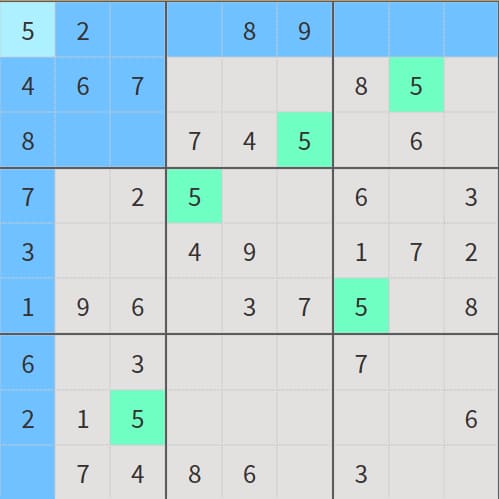Sudoku is more than just a grid of numbers – it’s a dance of logic, patience and creativity. So how do we solve it to enjoy this fascinating journey of Sudoku?
1. Understand the Basic Rules of Sudoku
Sudoku’s simplicity is its strength. Here’s what you need to know

- The Grid: A 9×9 grid divided into nine 3×3 subgrids (boxes).
- The Rule: Fill every row, column, and box with numbers 1–9 without repetition.
- The Clue: Puzzles start with 20–30 pre-filled numbers; your job is to deduce the rest.
- Pro Tip: No math required—just pure logic!
2. Start with Basic Skills, Build Your Foundation
Master these beginner techniques to solve most “easy” and “medium” puzzles
A. Scanning & Crosshatching
- Scanning: Look for rows/columns/boxes missing only one number.
- Example: If a row has 1,2,3,5,6,7,8,9, the missing number is 4.
- Crosshatching: Eliminate candidates in a box by checking rows and columns.
B. Pencil Marking
Write small numbers in empty cells to track possible candidates.
Naked Singles: Cells with only one possible number.
C. Practice Makes Progress
- Daily Drills: Solve 1–2 puzzles daily using apps like Sudoku.com.
- Track Time: Aim to solve “easy” puzzles in under 10 minutes.
3. Solutions to Difficulties: Conquer the Hardest Puzzles
When stuck on “hard” or “expert” Sudoku, use these advanced strategies
A. Hidden Pairs/Triples
Spot groups of numbers that only fit in specific cells within a unit.
Example: If cells A1, A3, and A5 can only be 2,4,6, remove these candidates from other cells in Row A.
B. X-Wing & Swordfish
X-Wing: A number forms a rectangle across two rows and columns, letting you eliminate candidates elsewhere.
Swordfish: A larger version involving three rows/columns.
C. Coloring & Chains
Chain Reactions: Link cells with “if-then” logic to uncover contradictions or certainties.
4. How Computers and AI Solve Sudoku
Modern tech cracks Sudoku in milliseconds. Here’s how
A. Backtracking Algorithms
Brute Force: Test candidates systematically and backtrack on errors.
Efficiency: Solves most puzzles in under a second.
B. Machine Learning
Neural Networks: AI models like MIT’s SuDoKuNet predict solutions by recognizing patterns.
Human vs. AI: Humans use intuition; AI uses probability matrices.
C. Tools to Try
Algorithm to solve Sudoku: Our Sudoku cracker is completely generated by AI. You can try to Solve Sudoku.
Puzzle Generators: Create custom grids with QQWing.
5. The Real Purpose of Sudoku: Play for Joy, Not Just Solutions
Sudoku isn’t about speed or bragging rights—it’s about the mental journey
- Brain Health: Lowers dementia risk by 30% in adults over 50 (Harvard Health). -> https://www.health.harvard.edu
- Mindful Focus: Treat it as meditation, not a chore.
- Pro Tip: If a puzzle frustrates you, switch to a lower difficulty or try a fun variant like Killer Sudoku!
April 16, 2025